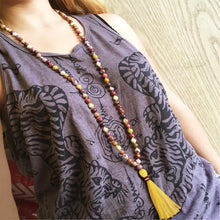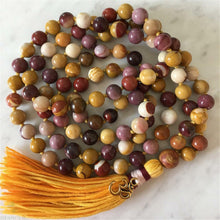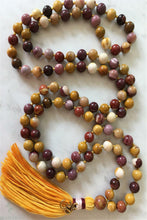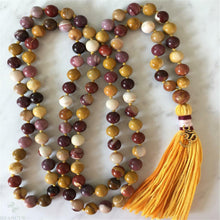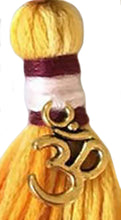
Mookaite Jasper 108 bead gemstone mala beads, hand-knotted mala strung on yellow orange silk with 3-5/8 inch tassel. Also spelled mookite.
Made in India. The gemstone prayer beads are knotted in between. 37 inches long give or take 1/2 inch.
Wear as a beautiful necklace or use during meditation to count off 108 breaths, mantras, or positive affirmation repetitions.
To keep silk threads of tassel straight, spritz with water and comb straight.
To cleanse, put your mala out under a full moon for half an hour and you're good to go. A great gift or caretakers.
Mookaite Jasper meaning:
Mookaite Jasper is great for artists or other creative types wanting to manifest bigger success in the corporate world. Mookaite Jasper is also recommended as protection for the brain to avoid Alzheimer's.
Mookaite Jasper also bestows the ease and resilience to easily adapt to change, which lowers stress and engenders youthfulness.
Mookaite Jasper helps the grieving cope with the drastic change of loss and to embrace death as another phase of life that is not the end of the spirit.
This Mookaite Jasper is from the Carnarvon Basin in Western Australia.
Prayer beads are called malas in Buddhism. They are like necklaces, but made to certain specifications and used for the purpose of meditation and prayer. Sometimes they are called malas necklace in the west
Malas are now a part of popular culture and are worn as necklaces as a fashion element.
Malas meaning
A mala is made up of beads that you hold, one at a time, to recite a mantra. There are 108 beads to hold so the mantra gets repeated 108 times. This practice is called sādhanā in Buddhism. The idea is that using the malas beads to track the number of repetitions frees the meditator to focus on the mantra.
When you repeat the mantra, you usually turn the bead you are at clockwise with your thumb. Although this is not always the case. Sometimes the custom is to turn the bead counterclockwise. And sometimes, you have to use a specific hand or finger instead of the thumb.
The beads can also be used to count slow deep breaths during meditation or to repeat the name of a holy person, such as Buddha or to count the number of times one bows down lies stretched out flat in prostration facing the floor.
The number of beads used in a mala has changed over time, but Tibetan Buddhist malas are still 108 beads. And most malas are 108 beads, but sometimes they may be 54, 28, 27 or 18.
21 or 28 may be used for doing bows or prostrations. I don't believe there is a wrong way to do a prostration, but it seems there are three basic kinds: the one where you completely lie face down flat on the floor, a partial bowing down from the knees, and a symbolic one where you are still standing or sitting and you show respect with your hands.
There is a bead that unifies the strand of 108 beads that is called a guru bead. It often feeds the ends of the cotton or silk floss that was used for the 108 beads into a tassel.
Sometimes, people in the west refer to a mala as a Buddhist rosary as they are familiar with Catholic prayer beads as rosaries.
There is historical significance to the number 108 in Buddhism. It represents the number of humanity's desires, which is also referred to as afflictions and called kleshas.
Sometimes, marker beads are added that are not to be counted. They are in addition to the 108 beads. They serve to bring one's attention back to the mantra as there can be a tendency for the mind to wander. Also, if you are starting to wonder how much further, the marker bead lets you know so that you don't have to think about time. A mala might have a different shaped or larger bead that is the marker bead every nine bead or every 27 beads.
Malas that are made for prayers for peace or for feeling more peaceful generally use beads made from clear or white gemstones, white lotus seeds and white shells. These prayers quiet the mind and clear confusion.
Malas that are made to increase something are made from a precious metal, such as gold or silver or from amber. These can be prayers to increase one's longevity or strength or wisdom.
Malas that are made to magnetize something desired into one's experience have beads made of seeds or wood, such as lotus seeds, sandalwood, rosewood or ebony.
Malas made for the purposes of taming a force or an individual use 108 beads made of bone or Rudraksha. The bone is often yak bone, but very old beads may be made from human bones, which is illegal to possess in America. Prayers to tame another should be done with the highest intention of seeing that individual aligned with their higher self. Taming harmful energies or spirits should be left to those who have attained a consciousness of true compassion for those spirits.
Buddhist prayer beads are called juzu which means counting beads or nenju, which means thought beads. There are different sects of Buddhism in Japan and each sect has its own style of prayer beads or juzus. The Shingon, Tendai and Nichiren sects use longer juzus. Jōdo Shinshū use shorter juzus and drape them over both of their hands. And the beads are used differently. For instance, there are those who rub their beads together as a purification practice. Certain sects and temples use juzus (prayer beads) that have a bead that is larger than the others and they put a little picture inside of that bead. That beads is translucent so that you can hold the bead up to the light and see the picture.
Om symbol charm measures 12.6mm by 19mm long.
Om meaning:
The Om symbol is a spiritual symbol in Hinduism. It is also a syllable and as a syllable is called a pravana. Om has a syllable dates back to the Upanishads, which is a set of mystical books about the Vedanta philosophy. Om is considered a sacred sound and is used a tool for meditation by a long expression of its sound: ooooohhhhhhhmmm. It is a mantra in the religions of Hinduism, Buddhism and Jainism.
Om is the first word of the mantra Om Mani Padmi Hum and scholars interpret this to be the totality of sound, existence and consciousness.





